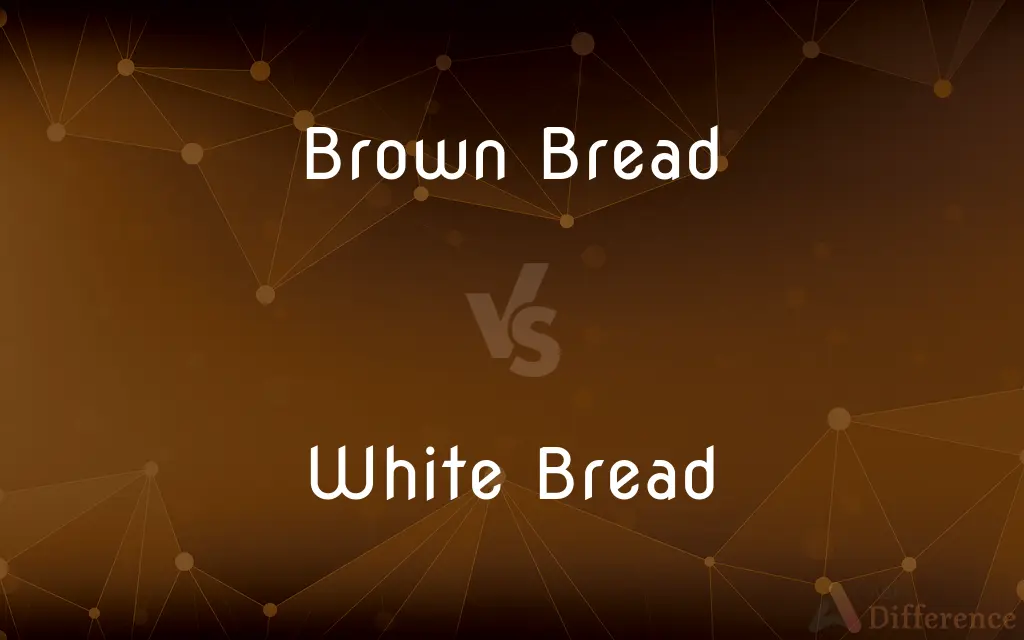Brown Bread vs. White Bread — What's the Difference?
By Urooj Arif & Fiza Rafique — Published on March 1, 2024
Brown bread, made with whole wheat flour, offers more fiber and nutrients than white bread, which is made from refined wheat flour, leading to differences in health benefits.

Difference Between Brown Bread and White Bread
Table of Contents
ADVERTISEMENT
Key Differences
Brown bread and white bread are staples in many diets, differing mainly in their ingredients and nutritional profiles. Brown bread, often synonymous with whole wheat or whole grain bread, is made using the entire wheat kernel, including the bran, germ, and endosperm. This composition retains more fiber, vitamins, and minerals, making it a healthier choice for those looking to improve digestion and maintain a balanced diet.
White bread, on the other hand, is made from refined wheat flour, where the bran and germ have been removed, leaving only the endosperm. This process results in a lighter, softer texture but significantly reduces the bread's nutritional value. While some white breads are fortified with vitamins and minerals to compensate for losses during refining, they typically still contain less fiber compared to their whole grain counterparts.
The higher fiber content in brown bread not only aids in digestion but also contributes to a feeling of fullness, which can help with weight management. Fiber's role in regulating sugar levels also makes brown bread a better option for those with diabetes or at risk of developing the condition.
Taste and texture preferences between the two types of bread can vary widely. Brown bread tends to have a denser, chewier texture and a nuttier flavor, while white bread is softer and has a milder taste. This makes white bread a popular choice for sandwiches and toast, though many appreciate the richer taste and health benefits of brown bread.
The choice between brown and white bread often comes down to personal preference, dietary needs, and health goals. Incorporating brown bread into one's diet can offer significant health benefits without sacrificing taste or satisfaction.
ADVERTISEMENT
Comparison Chart
Ingredients
Whole wheat flour (bran, germ, endosperm)
Refined wheat flour (endosperm only)
Nutritional Value
Higher in fiber, vitamins, and minerals
Lower in fiber, some vitamins and minerals added back after processing
Health Benefits
Aids in digestion, helps with weight management, regulates blood sugar
Less beneficial due to lower fiber content, but often fortified with vitamins
Texture
Denser and chewier
Softer and lighter
Flavor
Nuttier and richer
Milder and more neutral
Best Used For
Health-conscious diets, fuller meals
Light meals, sandwiches, where a softer texture is preferred
Compare with Definitions
Brown Bread
Made with whole wheat flour, retaining all parts of the grain.
Brown bread is my choice for a fiber-rich breakfast.
White Bread
Made from refined wheat flour, lacking bran and germ.
White bread is a staple for my kid's peanut butter and jelly sandwiches.
Brown Bread
Has a denser texture and nuttier flavor.
The dense texture of brown bread is perfect for my morning avocado toast.
White Bread
Lower in fiber and some nutrients, but often fortified.
I check the label to choose white bread that's fortified with vitamins.
Brown Bread
Offers more nutrients like fiber, vitamins, and minerals.
I prefer brown bread because it's packed with essential nutrients.
White Bread
Features a softer texture and milder flavor.
The softness of white bread makes it perfect for my morning toast.
Brown Bread
Aids in digestion and blood sugar regulation.
Brown bread helps me stay full longer and keeps my sugar stable.
White Bread
Less beneficial for digestion and weight management.
I eat white bread occasionally, but I know it's not the best for my diet.
Brown Bread
Suitable for health-conscious individuals.
Switching to brown bread was a part of my healthier diet plan.
White Bread
Popular for its lightness and versatility.
White bread is my go-to for quick and easy sandwiches.
White Bread
Alternative form of white bread
Common Curiosities
Is there a taste difference between brown and white bread?
Yes, brown bread has a nuttier, richer flavor, while white bread is milder and more neutral in taste.
Why is white bread considered less healthy?
It's made from refined flour that lacks fiber and essential nutrients, making it less beneficial, especially for digestion and sugar regulation.
Can diabetics eat brown bread?
Yes, brown bread is a better option for diabetics due to its ability to help regulate sugar levels, thanks to its higher fiber content.
Can eating brown bread help with weight loss?
Yes, due to its higher fiber content, brown bread can help you feel fuller longer, aiding in weight management.
Is brown bread the same as whole wheat bread?
Yes, brown bread is often used to refer to whole wheat or whole grain bread, made with all parts of the wheat kernel.
Can I make sandwiches with brown bread?
Absolutely, brown bread can be used for sandwiches and often adds a richer flavor and more texture to your meal.
How do I choose a healthy brown bread?
Look for labels that say "whole wheat" or "whole grain" as the first ingredient, and check for high fiber content.
Does brown bread have more calories than white bread?
The calorie content can be similar, but brown bread offers more nutritional benefits, making it a healthier choice overall.
Are there any fortified brown breads?
Yes, some brown breads are fortified with additional nutrients, though they naturally contain more vitamins and minerals than white bread.
Why does white bread have a softer texture?
The refining process removes the bran and germ, leaving only the starchy endosperm, which results in a softer texture.
Can white bread be part of a healthy diet?
In moderation and when chosen carefully (fortified options), white bread can be included in a balanced diet.
Is it okay to eat white bread every day?
While it's not harmful, diversifying your diet to include whole grains like brown bread can offer more health benefits.
Does the fiber in brown bread improve digestion?
Yes, the higher fiber content in brown bread helps promote healthy digestion and prevent constipation.
How should I store brown bread to keep it fresh?
Keep it in a cool, dry place, tightly sealed, or freeze it to extend its freshness.
Is brown bread more expensive than white bread?
It can be, due to the whole grains used, but prices vary by brand and location.
Share Your Discovery

Previous Comparison
Step Up Transformer vs. Step Down Transformer
Next Comparison
Energy Efficiency vs. Energy ConservationAuthor Spotlight
Written by
Urooj ArifUrooj is a skilled content writer at Ask Difference, known for her exceptional ability to simplify complex topics into engaging and informative content. With a passion for research and a flair for clear, concise writing, she consistently delivers articles that resonate with our diverse audience.
Co-written by
Fiza RafiqueFiza Rafique is a skilled content writer at AskDifference.com, where she meticulously refines and enhances written pieces. Drawing from her vast editorial expertise, Fiza ensures clarity, accuracy, and precision in every article. Passionate about language, she continually seeks to elevate the quality of content for readers worldwide.
















































